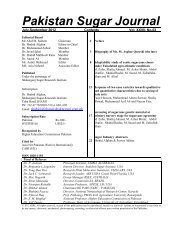Pakistan Sugar Journal - Shakarganj
Pakistan Sugar Journal - Shakarganj
Pakistan Sugar Journal - Shakarganj
You also want an ePaper? Increase the reach of your titles
YUMPU automatically turns print PDFs into web optimized ePapers that Google loves.
SUGAR INDUSTRY ABSTRACTS<br />
*Shahid Afghan & Pervez Akhtar<br />
*<strong>Shakarganj</strong> <strong>Sugar</strong> Research Institute, Jhang, Punjab, PAKISTAN<br />
Effect of harvest method on microclimate and sugarcane yield in Florida and Costa Rica<br />
R.A. Gilbert, G. Kingston, K. Morgan. R.W. Rice, L. Baucum, J.M. Shine and J.F. Subiros<br />
Agronomy, Proc. Int. Soc. <strong>Sugar</strong> Cane Technol., Vol.27, 2010 P.29<br />
There is worldwide pressure on sugarcane industries to adopt green cane harvesting systems that do not<br />
involve burning. The objective of this study was to compare the effect of sugarcane harvest methods on<br />
cane productivity and microclimate in Florida, U.S.A. and Costa Rica. The treatments included 1) burnt<br />
cane, 2) green cane, and 3) green cane with residue management. These treatments were implemented at<br />
three sites: A) Everglades Research and Education Center (EREC), Belle Glade, Florida on an Entisol<br />
with sandy texture, and C) Azucrera EI Viejo mill in Guanacaste, Costa Rica on a clay loam Inceptisol.<br />
The green cane residue provided a buffering effect on soil temperatures (15-cm depth) at the Florida<br />
muck site. There was a trend for higher biomass yields in burnt cane when harvested early (November-early<br />
January), and a significant cumulative 3 – year difference of 22 t/ha of cane favouring burnt vs.<br />
green cane treatments. However, cane yields were not different when harvested late in the season (mid-<br />
February-March)). On the Florida sand site. a decline in tiller population, particularly in green cane, was<br />
linked to frost events in February, 2006. Air temperatures at 10-cm aboveground were lower in green<br />
cane during frosts, which led to significantly lower tiller population in green cane in the first ratoon crop.<br />
Cane biomass yields on sand followed similar trends to those on the muck soil with burnt cane recording<br />
higher yields when harvested early but not significantly different when harvested late. At the Inceptisol<br />
site in Costa Rica, trash content, biomass and sucrose yields were not significantly different in green vs.<br />
burnt cane in the plant cane and first ratoon crops. In Costa Rica, cane residues reduced maximum soil<br />
temperatures by 5-10 o C for 3 months from harvest to canopy closure. Our results indicate the green cane<br />
residues have a significant effect on microclimate and that green harvest in Florida would be better suited<br />
for late rather than early harvest time periods.<br />
Agroclimatic zoning and climatic risks for sugarcane in Mexico: A preliminary study considering<br />
climate change scenarios<br />
O.Brunini.J.P.Carvalho, A.P.C.Bruninl, A.L.Padua Junior, S.F. Adami and P.L.G. Abramides<br />
Agronomy, Proc. Int. Soc. <strong>Sugar</strong> Cane Technol., Vol.27, 2010, P.30<br />
In the existing scenario of current agricultural management systems and climatic standards, a new source<br />
of uncertainties must be taken into account, namely, the temperature scenarios and water availability resulting<br />
from climate changes. In this respect, agricultural zoning, supported by the climatic and edaphological<br />
potential of a region, and the climate scenarios, along with the associated risks, have become highly<br />
relevant. This paper considers an example of the sugarcane crop in Mexico, indicating possible potential<br />
areas for crop development, and what are the climatic risks during plant growth, based on crop zoning<br />
criteria, as well as the impact of global warming in future scenarios. The agro climatic scope and the edaphological<br />
and climatic zoning were defined through the quantification of physical resources and the water<br />
balance parameters of different regions, indicating the relationship between energy availability, water<br />
supply and crop water demand. The study further determined the influence of climate changes in the<br />
quantification of the water balance for the regions and the effects of this anomaly in sugarcane development.<br />
The study was based on meteorological data from historic series from Mexican research institutes<br />
and from the National Metrological Service of Mexico,<br />
<strong>Pakistan</strong> <strong>Sugar</strong> <strong>Journal</strong> April-June 2012 20






